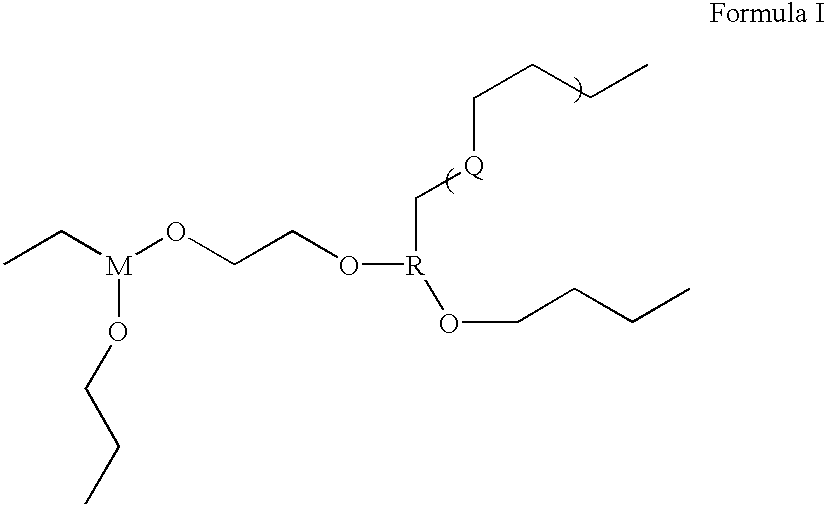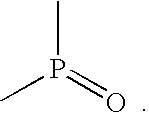Heteroatomic polymer for more efficient solid polymer electrolytes for lithium batteries
a solid polymer and lithium battery technology, applied in the direction of electrochemical generators, non-aqueous electrolyte cells, ion exchangers, etc., can solve the problems of poor mechanical properties, limited appeal, and persisting problems, and achieve the effect of greater amorphous character of polymers
- Summary
- Abstract
- Description
- Claims
- Application Information
AI Technical Summary
Benefits of technology
Problems solved by technology
Method used
Image
Examples
example 1
To prepare the oxyphosphorus polymer stoichiometric quantities of ethylphosphite and ethyelene glycol are added to anyhydrous methylene chloride with Nafion 117 pellets as an acid catalyst. The solution mixture is then heated to 60.degree. C. and refluxed under dry agron gas for 10 hours to effect the polymerization of the product. At the end of this period, the methylene chloride is removed using a rotary evaporator and the polymeric product is harvested, and purified using mutiple extractions with drymethylene chloride. The final product is dried overnight in a vacuum oven at 40.degree. C. ##STR9##
A similar procedure can be used to prepare polymers containing N and O as depicted below: ##STR10##
example 2
As an alternative, compounds of the general formula I can be prepared according to the following reaction scheme: ##STR11##
In this instance, stochiometric quantities of hydroxydimethylsiloxane is combined with trichlorophosphite and ethylene glycol in toluene and the mixture is acidified using Nafion 117 pellets as an acid catalyst. The solution mixture is then heated to 60.degree. C. and refluxed under dry argon gas for 10 hours to effect the polymerization of the product. At the end of this period, the methylene chloride is removed using a rotary evaporator and the polymeric product is harvested, and purified using mutiple extractions with drymethylene chloride. The final product is dried overnight in a vacuum oven at 40.degree. C. It is clear that the final product includes crosslinkages.
example 3
Using these polymers and salts of lithium, one can easily prepare solid polymer electrolytes for use in lithium batteries. In this manner, we have prepared a solid polymer electrolyte composed of a P, O polymer and lithium perchlorate (LiClO.sub.4) by dissolving the LiClO.sub.4 in anhydrous ethanol and then combining this solution with a 400 MW P, O polymer in an 8:1 Li.sup.+ :O, P ratio. This resulted in a viscous, clear liquid. An alternative approach is to dissolve the lithium salt and the polymer in dry methanol and then remove the methanol using a vacuum apparatus. The product is a clear film. Newer lithium salts such as lithium bisfluoroethanesulfonylimide (BETI) or lithium bisperfluoromethanesulfonylimide can also be used in place of lithium perchlorate.
PUM
| Property | Measurement | Unit |
|---|---|---|
| structure | aaaaa | aaaaa |
| weight ratio | aaaaa | aaaaa |
| ionic conductivity | aaaaa | aaaaa |
Abstract
Description
Claims
Application Information
 Login to View More
Login to View More - R&D
- Intellectual Property
- Life Sciences
- Materials
- Tech Scout
- Unparalleled Data Quality
- Higher Quality Content
- 60% Fewer Hallucinations
Browse by: Latest US Patents, China's latest patents, Technical Efficacy Thesaurus, Application Domain, Technology Topic, Popular Technical Reports.
© 2025 PatSnap. All rights reserved.Legal|Privacy policy|Modern Slavery Act Transparency Statement|Sitemap|About US| Contact US: help@patsnap.com



